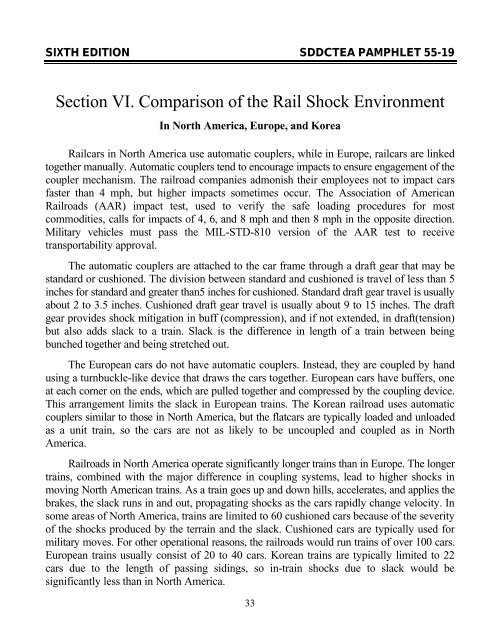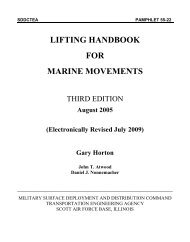Tiedown Handbook For Rail Movements - SDDCTEA - U.S. Army
Tiedown Handbook For Rail Movements - SDDCTEA - U.S. Army
Tiedown Handbook For Rail Movements - SDDCTEA - U.S. Army
Create successful ePaper yourself
Turn your PDF publications into a flip-book with our unique Google optimized e-Paper software.
SIXTH EDITION <strong>SDDCTEA</strong> PAMPHLET 55-19<br />
Section VI. Comparison of the <strong>Rail</strong> Shock Environment<br />
In North America, Europe, and Korea<br />
<strong>Rail</strong>cars in North America use automatic couplers, while in Europe, railcars are linked<br />
together manually. Automatic couplers tend to encourage impacts to ensure engagement of the<br />
coupler mechanism. The railroad companies admonish their employees not to impact cars<br />
faster than 4 mph, but higher impacts sometimes occur. The Association of American<br />
<strong>Rail</strong>roads (AAR) impact test, used to verify the safe loading procedures for most<br />
commodities, calls for impacts of 4, 6, and 8 mph and then 8 mph in the opposite direction.<br />
Military vehicles must pass the MIL-STD-810 version of the AAR test to receive<br />
transportability approval.<br />
The automatic couplers are attached to the car frame through a draft gear that may be<br />
standard or cushioned. The division between standard and cushioned is travel of less than 5<br />
inches for standard and greater than5 inches for cushioned. Standard draft gear travel is usually<br />
about 2 to 3.5 inches. Cushioned draft gear travel is usually about 9 to 15 inches. The draft<br />
gear provides shock mitigation in buff (compression), and if not extended, in draft(tension)<br />
but also adds slack to a train. Slack is the difference in length of a train between being<br />
bunched together and being stretched out.<br />
The European cars do not have automatic couplers. Instead, they are coupled by hand<br />
using a turnbuckle-like device that draws the cars together. European cars have buffers, one<br />
at each corner on the ends, which are pulled together and compressed by the coupling device.<br />
This arrangement limits the slack in European trains. The Korean railroad uses automatic<br />
couplers similar to those in North America, but the flatcars are typically loaded and unloaded<br />
as a unit train, so the cars are not as likely to be uncoupled and coupled as in North<br />
America.<br />
<strong>Rail</strong>roads in North America operate significantly longer trains than in Europe. The longer<br />
trains, combined with the major difference in coupling systems, lead to higher shocks in<br />
moving North American trains. As a train goes up and down hills, accelerates, and applies the<br />
brakes, the slack runs in and out, propagating shocks as the cars rapidly change velocity. In<br />
some areas of North America, trains are limited to 60 cushioned cars because of the severity<br />
of the shocks produced by the terrain and the slack. Cushioned cars are typically used for<br />
military moves. <strong>For</strong> other operational reasons, the railroads would run trains of over 100 cars.<br />
European trains usually consist of 20 to 40 cars. Korean trains are typically limited to 22<br />
cars due to the length of passing sidings, so in-train shocks due to slack would be<br />
significantly less than in North America.<br />
33




